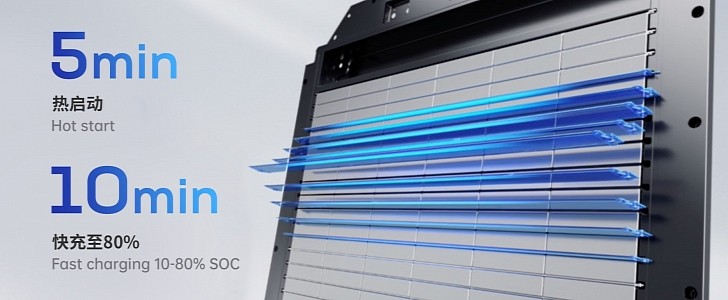Cell-to-pack (CTP) is a way to put cells together and use all the space available to pack as much energy as possible. CATL was one of the first companies to propose this assembly method. On March 28, we wrote that the Chinese battery maker had just presented the third generation CTP. It was supposed to be called Kirin. On June 23, CATL disclosed more information about this new CTP and changed its name: it’s Qilin (you read it tcheeleen). Issues with the Japanese beer, anyone?
The new module-less battery pack achieved the highest volume utilization efficiency ever: 72%. That means the Qilin battery pack has 72% of its volume dedicated to batteries, not to the structures that protect it or manage its temperature. Another way to talk about that is to say that the Qilin has an energy density of 255 Wh/kg when its prismatic cells use the NMC or NCA chemistries – ternary cells, for those more familiar with the battery jargon.
Despite being Tesla’s primary battery supplier, CATL is not afraid to say that its CTP 3.0 pack offers 13% more energy density than one with 4680 cells. You’ll remember that these are the batteries Tesla once said would give it an edge no other carmaker would have. So far, all they helped Tesla achieve was to turn Giga Austin into a money furnace, in Elon Musk’s own words. CATL even created a graphic showing how superior its solution is when compared to Tesla’s. The Qilin battery pack with ternary cells may offer a range of more than 1,000 kilometers (621 miles).
Cylindrical cells have an advantage in the sense that they are faster and cheaper to produce. Despite that, most carmakers agree that the best battery format for electric cars is the prismatic one. Volkswagen is developing its unified cells in this form, for example. With the Qilin battery pack, CATL reinforced the arguments favoring prismatic cells.
It is this format that allows it to pack more energy in the same space. CATL also developed “a multifunctional elastic interlayer” that replaced “the internal crossbeam, liquid-cooling plate, and thermal pad” all at once. Summing up, the prismatic cell rows are interposed with these interlayers to heat the cells in cold weather and cool them down when they get hotter than advisable. The CTP 3.0 battery pack even has a protective vent for thermal runaway risks.
LFP cells are not subject to that. With them, the Qilin offers an energy density of 160 Wh/kg. Unfortunately, CATL did not say how far a vehicle could go with an LFP-Qilin battery pack. In a rapid calculation, we estimate such a vehicle could run 627 km (389.6 mi), which is better than the range many vehicles with ternary cells currently offer.
CATL said the Qilin battery pack would be available next year. We just have to learn which carmaker will be the first to buy it and put it to work in its vehicles. CATL promises a 5-minute hot start and fast charging from 10% to 80% of state-of-charge (SOC) capacity in 10 minutes. If the Chinese giant delivers on these promises, it will be easier to discover which companies will not buy the CTP 3.0 battery packs.
Despite being Tesla’s primary battery supplier, CATL is not afraid to say that its CTP 3.0 pack offers 13% more energy density than one with 4680 cells. You’ll remember that these are the batteries Tesla once said would give it an edge no other carmaker would have. So far, all they helped Tesla achieve was to turn Giga Austin into a money furnace, in Elon Musk’s own words. CATL even created a graphic showing how superior its solution is when compared to Tesla’s. The Qilin battery pack with ternary cells may offer a range of more than 1,000 kilometers (621 miles).
Cylindrical cells have an advantage in the sense that they are faster and cheaper to produce. Despite that, most carmakers agree that the best battery format for electric cars is the prismatic one. Volkswagen is developing its unified cells in this form, for example. With the Qilin battery pack, CATL reinforced the arguments favoring prismatic cells.
It is this format that allows it to pack more energy in the same space. CATL also developed “a multifunctional elastic interlayer” that replaced “the internal crossbeam, liquid-cooling plate, and thermal pad” all at once. Summing up, the prismatic cell rows are interposed with these interlayers to heat the cells in cold weather and cool them down when they get hotter than advisable. The CTP 3.0 battery pack even has a protective vent for thermal runaway risks.
LFP cells are not subject to that. With them, the Qilin offers an energy density of 160 Wh/kg. Unfortunately, CATL did not say how far a vehicle could go with an LFP-Qilin battery pack. In a rapid calculation, we estimate such a vehicle could run 627 km (389.6 mi), which is better than the range many vehicles with ternary cells currently offer.
CATL said the Qilin battery pack would be available next year. We just have to learn which carmaker will be the first to buy it and put it to work in its vehicles. CATL promises a 5-minute hot start and fast charging from 10% to 80% of state-of-charge (SOC) capacity in 10 minutes. If the Chinese giant delivers on these promises, it will be easier to discover which companies will not buy the CTP 3.0 battery packs.












